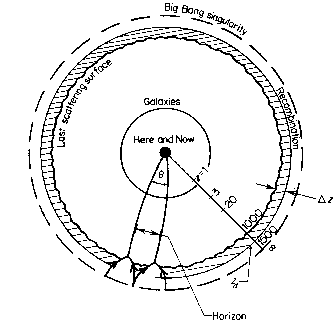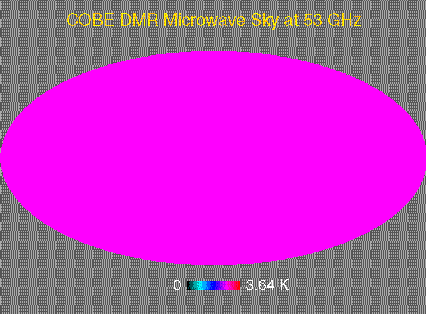The Cosmic Microwave Background Radiation
Perhaps the most conclusive, and certainly among the most carefully examined,
piece of evidence for the Big Bang is the existence of an isotropic radiation
bath that permeates the entirety of the Universe known as the
"cosmic microwave background" (CMB).
In 1964, two young radioastronomers, Arno Penzias and Robert Wilson,
accidentally discovered the CMB using a well-calibrated horn antenna.
It was soon determined that the radiation was diffuse, emanated unifromly
from all directions in the sky, and had a temperature of approximately
3 Kelvin (2.73K).
Initially, the two young scientists were berefit of a satisfactory explanation
for their observations, and considered the possibility that the CMB may have
been due to some undetermined systematic noise.
However, it soon came to their attention through Robert Dicke and Jim Peebles
of Princeton that this background radiation had in fact been predicted years
earlier (1948) by George Gamow, Ralph Alpher, & Robert Herman as a relic
of the evolution of the early Universe.
More history in abbreviated form is in this
CMB time line .
The universe was once very hot and dense, the photons and baryons
would have formed a plasma.
As the universe expanded and cooled there came a point when the radiation (photons)
decoupled from the matter.
The radiation cooled and is now at 2.73 Kelvin.
The fact that the spectrum (see figure)
of the radiation is almost exactly that of a black body implies
that it could not have had its origin through any prosaic means.
This has led to the death of the
steady state theory.
 This diagram, centered on the observer (you), shows a representation of
the universe where the angle represents the angle of view and the
distance (radius) from the center measures both distance and time
since light travels at a finite speed.
The scale is non-linear and maked in terms of redshift z
which is the fractional amoumt by which emitted light is
stretched by the expansion of the Universe in the travel time
from its emission and reaching the observer.
The Universe changes scale by a factor (1 + z) in this time
and the light wavelength changes by the same factor.
This diagram, centered on the observer (you), shows a representation of
the universe where the angle represents the angle of view and the
distance (radius) from the center measures both distance and time
since light travels at a finite speed.
The scale is non-linear and maked in terms of redshift z
which is the fractional amoumt by which emitted light is
stretched by the expansion of the Universe in the travel time
from its emission and reaching the observer.
The Universe changes scale by a factor (1 + z) in this time
and the light wavelength changes by the same factor.
The temperature of the cosmic background radiation changes down
by the same factor (1 + z).
At early epochs (for z>1000), this temperature was high enough that most
of the universe- was ionized, and therefore opaque ("optically thick").
The surface z=1000 is sometimes called the cosmic photosphere,
in comparison with the photosphere (apparent surface) of the Sun.
It is the surface from which the cosmic background photons last
scattered before coming to us.
The light coming from this cosmic photosphere (surface of last scattering)
can be used to make an image of the early Universe.
One can then learn about the Universe when it was a 1000 times
smaller than the present.
In 1967 Sachs and Wolfe determined that any observed temperature variations
were directly related to variations in the density variations
at that time.
However at the time, cosmologists, having very litle data, fell back
on the Cosmological Principle: which states that the universe,
on the average, looks the same from any point.
It is motivated by the Copernican argument that the Earth is not in a
central, preferred position.
If the universe is locally locally isotropic, as viewed from any point,
it is also uniform.
So the cosmological principle states that the universe is
approximately isotropic and homogeneous, as viewed
by any observer at local rest.
(See
U2 Anisotropy Experiment for the effect of observer
motion.)
The CMB should then appear to be approximately isotropic.
Further investigations, including more recent ones by the
COBE
satellite (Smoot et. al.),
confirmed the virtual isotropy of the CMB to better than one part in
ten-thousand.

A map of the sky at microwave frequencies, showing that the CMB is
almost completely the same in all directions.
Given this qualification checked in limited regions by small angular scale
observations, any attempt to interpret the origin of the CMB as due to present
astrophysical phenomena (i.e. stars, radio galaxies, etc.) is discredited.
Therefore, the only satisfactory explanation for the existence of the CMB
lies in the physics of the early Universe.
While the CMB is predicted to be very smooth, the lack of features cannot be
perfect.
At some level one expects to see irregularities, or anisotropies,
in the temperature of the radiation.
These temperature fluctuations are the imprints of processes and
features of the early universe.
The COBE DMR
instrument first detected these imprints and made them public in 1992.
Usually the features of the Universe and the CMB are interpreted
in the context of a cosmological model -
The Big Bang -
which is derived from general
cosmological principles and observations.
Some of the features of the Big Bang model are discussed in the
Science Goals
subsection on the
Origin of Large Scale Structure.
Pictograph of Signal Flow Concept
for attaining cosmological model tests and parameters from CMB observations.
Words on signal flow Software concept
Page still under construction, please bear with us...
Return to Smoot Group page.
 This diagram, centered on the observer (you), shows a representation of
the universe where the angle represents the angle of view and the
distance (radius) from the center measures both distance and time
since light travels at a finite speed.
The scale is non-linear and maked in terms of redshift z
which is the fractional amoumt by which emitted light is
stretched by the expansion of the Universe in the travel time
from its emission and reaching the observer.
The Universe changes scale by a factor (1 + z) in this time
and the light wavelength changes by the same factor.
This diagram, centered on the observer (you), shows a representation of
the universe where the angle represents the angle of view and the
distance (radius) from the center measures both distance and time
since light travels at a finite speed.
The scale is non-linear and maked in terms of redshift z
which is the fractional amoumt by which emitted light is
stretched by the expansion of the Universe in the travel time
from its emission and reaching the observer.
The Universe changes scale by a factor (1 + z) in this time
and the light wavelength changes by the same factor.
